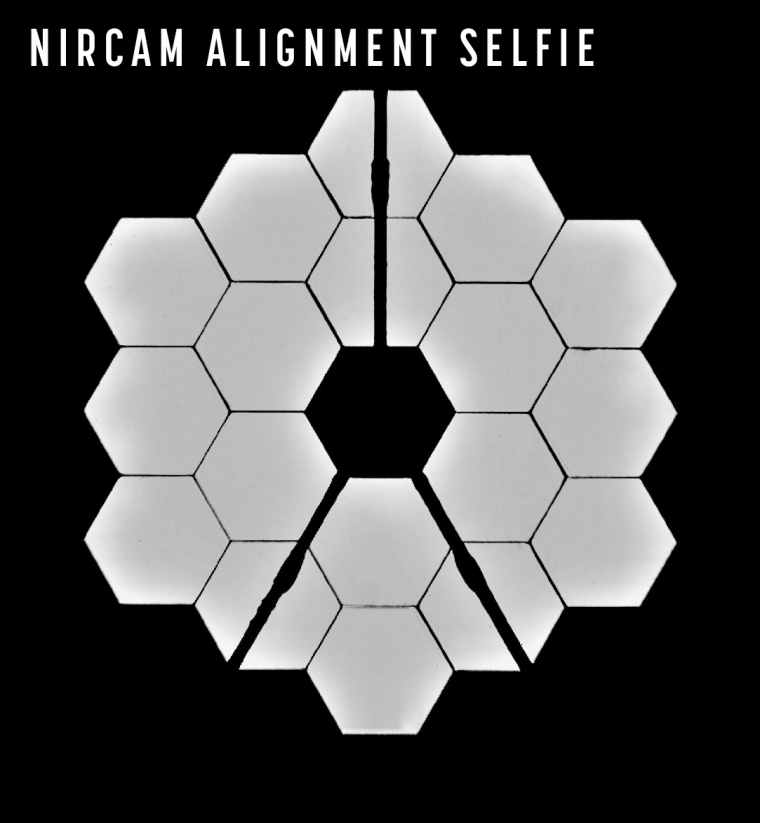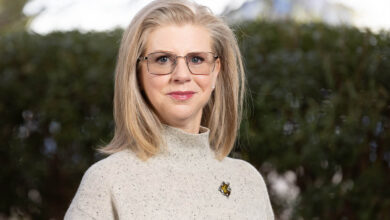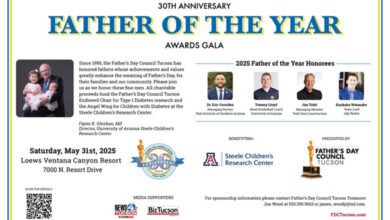
James Webb Telescope Produces First Clear Image of Star
The University of Arizona-developed and managed Near Infrared Camera onboard NASA’s James Webb Space Telescope has helped the telescope achieve an important mission milestone: the completion of critical mirror alignment steps, culminating in Webb’s first focused image of a single star.
Over the last few months, UArizona’s Near Infrared Camera, or NIRCam, has been used to focus Webb’s 18 mirror segments. First, Webb’s unaligned mirrors produced a mosaic of 18 images of the same star. Then, the mirrors aligned enough to create an image of a single out-of-focus star. The latest image, released Wednesday by NASA, shows a different target star from previous images, and confirms that Webb’s optical performance will be able to meet or exceed the science goals the observatory was built to achieve.
The Webb team also took another primary mirror “selfie” now that the mirrors are totally aligned. In February, NASA released an image that showed the 18 mirror segments as they look from the secondary mirror. In that “selfie” image, one of the mirror segments glowed more brightly than the rest because it was pointed at the bright star HD 84406, while the 17 others weren’t in the same alignment. Now that the mirrors are aligned, all mirror segments glow brightly in the latest selfie. The image was created using a specialized pupil imaging lens inside NIRCam.

While the photos captured so far, known as “engineering images,” mark major milestones and confirm that Webb is a functional telescope that will be able to achieve its science goals, there is still much to be done in the coming months to prepare the rest of the observatory for full scientific operations using all four of its instruments. The first “pretty” images, taken for scientific purposes, are expected in the summer.
The latest milestone
On March 11, the Webb team completed the stage of alignment known as fine phasing. At this key stage in the commissioning of Webb’s Optical Telescope Element, every optical parameter that has been checked and tested is performing at or above expectations. The team also found no critical issues and no measurable contamination or blockages to Webb’s optical path. The observatory can successfully gather light from distant objects and deliver it to its instruments without issue.
“Demonstrating this high level of optical performance ensures that NIRCam will deliver the science results that everyone is hoping for,” said Marcia Rieke, principal investigator for the NIRCam instrument and a UArizona Regents Professor of Astronomy. “The telescope is working absolutely fabulously and will reveal the fine details that we want to see.”
Although there are months to go before Webb ultimately delivers its new view of the cosmos, achieving this fine phasing milestone means the team is confident that Webb’s first-of-its-kind optical system is working as well as possible.
“More than 20 years ago, the Webb team set out to build the most powerful telescope that anyone has ever put in space and came up with an audacious optical design to meet demanding science goals,” said Thomas Zurbuchen, associate administrator for NASA’s Science Mission Directorate in Washington, D.C. “Today, we can say that design is going to deliver.”
While some of the largest ground-based telescopes on Earth use segmented primary mirrors, Webb is the first telescope in space to use such a design. The 21-foot, 4-inch primary mirror – much too big to fit inside a rocket nosecone – is made up of 18 hexagonal, gold-plated, beryllium mirror segments. It had to be folded up for launch and then unfolded in space before each mirror was adjusted – to within nanometers – to form a single mirror surface.
“In addition to enabling the incredible science that Webb will achieve, the teams that designed, built, tested, launched and now operate this observatory have pioneered a new way to build space telescopes,” said Lee Feinberg, Webb optical telescope element manager at NASA’s Goddard Space Flight Center in Greenbelt, Maryland.
With the fine phasing stage of the telescope’s alignment complete, the team has now fully aligned Webb’s primary imager, NIRCam, to the observatory’s mirrors.
“We have fully aligned and focused the telescope on a star, and the performance is beating specifications. We are excited about what this means for science,” said Ritva Keski-Kuha, deputy optical telescope element manager for Webb at NASA Goddard. “We now know we have built the right telescope.”
Over the next six weeks, the team will proceed through the remaining alignment steps before final science instrument preparations. The team will further align the telescope to include the Near-Infrared Spectrograph, the Near InfraRed Imager and Slitless Spectrograph and the Mid-Infrared Instrument, or MIRI, which is led by UArizona Regents Professor of Astronomy George Rieke. In this phase of the process, an algorithm will evaluate the performance of each instrument and then calculate the final corrections needed to achieve a well-aligned telescope across all science instruments. Following this, Webb’s final alignment step will begin, and the team will adjust any small, residual positioning errors in the mirror segments.
The team is on track to conclude all aspects of Optical Telescope Element alignment by early May, if not sooner, before moving on to approximately two months of science instrument preparations. Webb’s first full-resolution imagery and science data will be released in the summer.
Launched on Dec. 25, Webb is the world’s premier space science observatory and NASA’s top science priority. UArizona astronomers played key roles in designing and developing the telescope’s infrared eyes. Once fully operational, Webb will help solve mysteries in our solar system, look beyond to distant worlds around other stars, and probe the mysterious structures and origins of our universe and our place in it. Webb is an international program led by NASA with its partners at the European Space Agency and the Canadian Space Agency.





